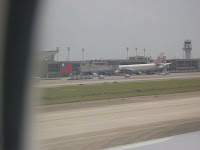This, a public holiday in Singapore, fell on a Monday, and I took the opportunity to travel to Taiwan. Or, the Republic of China, the refuge of General Chiang Kai-shek's Kuomintang Party, which was defeated by the communists in the Chinese Civil War. Taiwan has a much older history, and its aboriginal peoples have inhabited the island for thousands of years. The KMT fled there in 1949, upon their defeat, and helped transform the island.
I took an early Saturday flight, out of Changi Airport's beautiful new Terminal 3, for a few days in Taipei, the capital located in the northern part of this island just across the Taiwan Strait from China.
Modern Taiwan has an interesting history. It has evolved from its origins under an iron-fisted, single political party, when the country was widely recognized globally (in a diplomatic sense), to its status today as a multi-party democracy that is a diplomatic outcast. China (the People's Republic) refuses to recognize the sovereignty of Taiwan, and most of the rest of the world follows. Still, Taiwan is a thriving, modern economy. And its newly elected president, Ma Ying-jeou, has signaled his interest in bridging the differences between the two countries, helping thaw relations since his March election.

We landed on a sunny day, and I was greeted with the sight of the Republic of China flag flapping in the breeze. I think this is one of the more attractive flags, with a red background and white sun in a blue union in the northwest corner. It was adopted as the flag of the Republic of China in 1928, when nationalist forces toppled the warlord government that had held power since the fall of the Qing (or Manchu) Dynasty in 1912. For many, it serves as a historical link to mainland China. For me, it was notice that I was in for a new and different experience.

In most of my travels, I have been able to communicate with locals using English, and many signs are in English (whether in Thailand, Hong Kong, or Vietnam). Taipei would be different. There had been only a small Western colonial presence, and while one could see English on street signs and at the airport, it was not spoken or even understood by a large part of the population. I was in Taiwan, and the people in Taiwan speak Taiwanese. It would make for some interesting moments.
The airport is more than 40 kilometres southwest of the the city centre, so I was able to see some of the sights from my hired car on the way to the hotel. Taipei sits in a valley ringed by leafy hills, which adds a touch of serenity to the city. For some reason, I was reminded of a US city, perhaps in part because the Taiwanese drive on the right side of the road. Most of the signage was in Taiwanese, but this city seemed different than others in Asia. I couldn't put my finger on it (and I still don't think I can), but I felt very comfortable right away.


Les Suites Taipei - my hotel - is a small boutique hotel, fortunately within 100 metres of an MRT station (pictured above). I have lucked out with this in Hong Kong, as well, and I can't stress how much that improves the visit. The MRT is very efficient, and I was able to avoid taking taxis for nearly my entire stay there, keeping to the rails. After dropping off my luggage, I was ready to start exploring. First stop: Taipei 101.
No comments:
Post a Comment